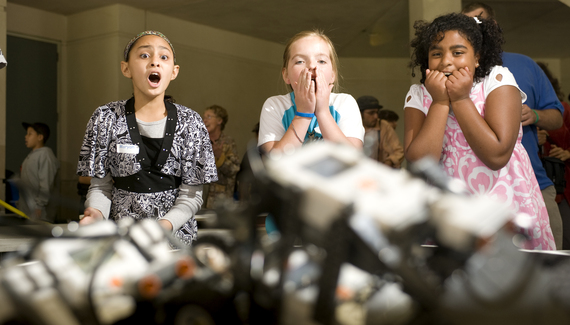
Photo by Tom Zasadzinski.
Elementary school students showing off their sumo robots
You are a teacher, and you are excited about your upcoming class. You work hard, prepare a nice lecture, go to your class, and deliver a great presentation full of passion. Students seem to be listening to you, and you feel accomplished. You then ask a question to reaffirm that students understand the subject matter so you can move on to the next topic. The question is fairly straightforward--at least in your mind--and you are confident that everyone knows the answer.
You eagerly await their response. Alas, no one ventures to answer. Surprised at this turn of events, you repeat the question, thinking they hadn't heard it. You then rephrase it, hoping that will make it clearer. Still no one responds. Or perhaps one or two hands go up hesitantly. Further probing reveals that no one really knows the answer, and you are frustrated.
If this happened to you, and you are wondering what went wrong, you are not alone. In my early days of teaching, I have had a countless number of such incidents, and I would get very angry inside: "Here I'm doing all I can to help my students, but they still don't get it! What is wrong with them?"
Asking questions is an important step in the learning process. In fact, the ancient Socratic method of teaching is based on asking questions to engage students and help them to develop critical thinking skills. Why is it not working? Students often don't want to reply because they don't want to say something "wrong" and make a fool of themselves in front of others.
Is there a non-intimidating, thought-provoking question that arouses a serious response from students?
- Seeking students' opinions makes them feel that you value their input and respect them. They, in turn, think of you highly, thus creating a favorable learning environment.
- This may be the only answer-neutral question. In other words, it has no right or wrong answers, which gives students the confidence they need to respond without hesitation.
- By asking, "What do you think?", you are elevating your students from mere observers to active participants in the discussion.
Do not add any additional words that will imply an answer. For example, "Don't you think we should do this?" is very different from "What do you think?"
To take full advantage of this student engagement opportunity, you must first build a good rapport with them, which starts on day one and continues throughout the year. Rapport creates a respectful, friendly environment in which students know you are genuinely interested in them and they trust you. Do not use the "What do you think?" question as a trap to ridicule students as some college professors do.
If an awkward silence occurs, embrace it. Silence is good. Once it is broken, floodgates of ideas will open.
Another crucial aspect is what you do after asking the question: you must simply wait. Don't be impatient. Don't start prompting or talking. If an awkward silence occurs, embrace it. Silence is good. Once it is broken, floodgates of ideas will open. Just wait for them to start. It takes time for anyone to develop ideas and express them clearly. Most adults can't do that easily, but these are students. Give them time, and soon all of your students will be talking to you.
I have successfully used this approach in numerous situations, ranging from third-grade classrooms to design classes for engineers. I continue to use it, and it always works. Below is an interaction with a fourth-grade student in a robotics class I was teaching once a week for about 15 weeks. In this particular session, students were programming their robot to accomplish a task.
__________________________________________________
Jennifer said, "Dr. Jawa, my robot is not working."
I responded, "What do you think, Jennifer?"
I waited. Jennifer was quiet for a moment, apparently thinking hard. Then she hesitantly said, "Maybe the wires are not connected properly."
I kept quiet and didn't say anything. She paused for a moment and finally said, "Okay, I will check the connections."
A few minutes later, she came back and said, "Dr. Jawa, my robot is still not working."
I asked her again, "What do you think?"
I then just waited. She stood there for a while and then said, "I will have to check my battery." She proceeded to check her battery for power.
We went through a few more iterations: "Perhaps the wheels are stuck," "The motor is not working," "The wire is faulty," etc., and my response always was, "What do you think?" Each time, she would state a possible cause and identify a potential solution herself.
Finally, after exhausting all or almost all issues related to hardware, it occurred to her that her code (software) was likely the problem. She hurriedly left and went to her computer, where I saw her intently focused on the screen. Within a few minutes she fixed the code, and her robot started to work. From where I was sitting, I could see a proud, confident young girl smiling.
__________________________________________________
This entire incident took about 15 minutes, but Jennifer came out of this experience with real learning and satisfaction. I could have solved her problem easily by giving her the answer, but that would have deprived her from finding the solution herself. Most of all, she did all the work; I did nothing but ask her the same thought-provoking question again and again. What a great way to teach--to ask a question and let the students figure out answers on their own!
The question, "What do you think?", when posed properly, can help students experience the joy of discovery.
Thanks for reading! If you enjoy this blog please share it with your friends!
